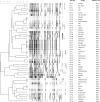Persistence, transmission, and virulence characteristics of Aeromonas strains in a duckweed aquaculture-based hospital sewage water recycling plant in Bangladesh
- PMID: 17194839
- PMCID: PMC1828788
- DOI: 10.1128/AEM.01901-06
Persistence, transmission, and virulence characteristics of Aeromonas strains in a duckweed aquaculture-based hospital sewage water recycling plant in Bangladesh
Abstract
The persistence and transmission of Aeromonas in a duckweed aquaculture-based hospital sewage water treatment plant in Bangladesh was studied. A total of 670 samples from different sites of the hospital sewage water treatment plant, from feces of hospitalized children suffering from diarrhea, from environmental control ponds, and from feces of healthy humans were collected over a period of three years. In total, 1,315 presumptive Aeromonas isolates were biochemically typed by the PhenePlate rapid screening system (PhP-AE). A selection of 90 representative isolates was further analyzed with PhenePlate (PhP) extended typing (PhP-48), fatty acid methyl ester analysis, and amplified fragment length polymorphism (AFLP) fingerprinting. In addition, the prevalence of the putative virulence factors hemolysin and cytotoxin and the presence of the cytolytic enterotoxin gene (AHCYTOEN) were analyzed. Aeromonas was found at all sites of the treatment plant, in 40% of the samples from environmental control ponds, in 8.5% of the samples from hospitalized children suffering from diarrhea, and in 3.5% of samples from healthy humans. A significantly high number of Aeromonas bacteria was found in duckweed, which indicates that duckweed may serve as a reservoir for these bacteria. PhP-AE typing allowed identification of more than 192 distinct PhP types, of which 18 major PhP types (MTs) were found in multiple sites and during several occasions. AFLP fingerprinting revealed the prevalence of genotypically indistinguishable Aeromonas isolates among certain PhP MTs recovered from different sampling occasions and/or at multiple sites. Hemolytic and cytotoxic activities were observed in 43% of the tested strains, whereas 29% possessed the cytolytic enterotoxin gene AHCYTOEN. Collectively, two specific MTs associated with diarrhea were shown to exhibit high cytotoxicity. Furthermore, all tested isolates of these major types were positive for the cytolytic enterotoxin gene. In conclusion, our data indicate that certain phenotypically and genotypically stable clonal lineages of Aeromonas have persisted in the treatment system for a prolonged period and might spread from the hospitalized children suffering from diarrhea to fish produced for human consumption through the sewage water treatment system.
Figures

Similar articles
-
Prevalence and transmission of antimicrobial resistance among Aeromonas populations from a duckweed aquaculture based hospital sewage water recycling system in Bangladesh.Antonie Van Leeuwenhoek. 2009 Oct;96(3):313-21. doi: 10.1007/s10482-009-9348-1. Epub 2009 May 21. Antonie Van Leeuwenhoek. 2009. PMID: 19459063
-
Identification and characterization of pathogenic Aeromonas veronii biovar sobria associated with epizootic ulcerative syndrome in fish in Bangladesh.Appl Environ Microbiol. 2002 Feb;68(2):650-5. doi: 10.1128/AEM.68.2.650-655.2002. Appl Environ Microbiol. 2002. PMID: 11823203 Free PMC article.
-
Characterization of Aeromonas spp. isolated from humans with diarrhea, from healthy controls, and from surface water in Bangladesh.J Clin Microbiol. 1997 Feb;35(2):369-73. doi: 10.1128/jcm.35.2.369-373.1997. J Clin Microbiol. 1997. PMID: 9003598 Free PMC article.
-
[Bacteria of the genus Aeromonas and their role in aquaculture].Mikrobiol Zh (1978). 1992 Jul-Aug;54(4):89-99. Mikrobiol Zh (1978). 1992. PMID: 1406386 Review. Russian.
-
The genus Aeromonas: A general approach.Microb Pathog. 2019 May;130:81-94. doi: 10.1016/j.micpath.2019.02.036. Epub 2019 Mar 5. Microb Pathog. 2019. PMID: 30849490 Review.
Cited by
-
Toxicity of Crude Extracellular Products of Aeromonas hydrophila on Rohu, Labeo rohita (Ham.).Indian J Microbiol. 2011 Oct;51(4):515-20. doi: 10.1007/s12088-011-0182-6. Epub 2011 May 1. Indian J Microbiol. 2011. PMID: 23024416 Free PMC article.
-
A review on pathogenicity of Aeromonas hydrophila and their mitigation through medicinal herbs in aquaculture.Heliyon. 2023 Feb 28;9(3):e14088. doi: 10.1016/j.heliyon.2023.e14088. eCollection 2023 Mar. Heliyon. 2023. PMID: 36938468 Free PMC article. Review.
-
Antibiotic resistance in Aeromonas upstream and downstream of a water resource recovery facility.Water Environ Res. 2014 Sep;86(9):835-43. Water Environ Res. 2014. PMID: 25327024 Free PMC article.
-
Determination of microbial diversity of Aeromonas strains on the basis of multilocus sequence typing, phenotype, and presence of putative virulence genes.Appl Environ Microbiol. 2011 Jul;77(14):4986-5000. doi: 10.1128/AEM.00708-11. Epub 2011 Jun 3. Appl Environ Microbiol. 2011. PMID: 21642403 Free PMC article.
-
Distribution of virulence factors and molecular fingerprinting of Aeromonas species isolates from water and clinical samples: suggestive evidence of water-to-human transmission.Appl Environ Microbiol. 2010 Apr;76(7):2313-25. doi: 10.1128/AEM.02535-09. Epub 2010 Feb 12. Appl Environ Microbiol. 2010. PMID: 20154106 Free PMC article.
References
-
- Alaerts, G. J., M. R. Mahbubar, and P. Kelderman. 1996. Performance analysis of a full-scale duckweed-covered sewage lagoon. Water Res. 30:843-852.
-
- Albert, M. J., M. Ansaruzzaman, K. A. Talukder, A. K. Chopra, I. Kuhn, M. Rahman, A. S. Faruque, M. S. Islam, R. B. Sack, and R. Mollby. 2000. Prevalence of enterotoxin genes in Aeromonas spp. isolated from children with diarrhea, healthy controls, and the environment. J. Clin. Microbiol. 38:3785-3790. - PMC - PubMed
-
- Araujo, R. M., R. M. Arribas, and R. Pares. 1991. Distribution of Aeromonas species in waters with different levels of pollution. J. Appl. Bacteriol. 71:182-186. - PubMed
-
- Bukhari, Z., H. V. Smith, N. Sykes, S. W. Humphreys, C. A. Paton, R. W. A. Girdwood, and C. R. Fricker. 1997. Occurrence of Cryptosporidium spp. oocysts and Giardia spp. cysts in sewage influents and effluents from treatment plants in England. Water Sci. Technol. 35:385-390.
Publication types
MeSH terms
Substances
LinkOut - more resources
Full Text Sources

